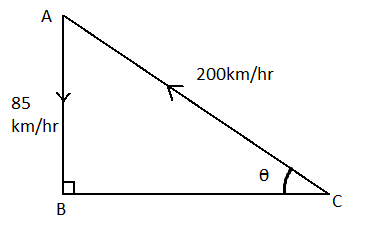
Answer
445.5k+ views
Hint:Just keep in mind that the speed of an object in still air is equal to the speed relative to the air, no matter whether the air is moving or not relative to the ground. Also, to get in the north direction all the resultant of all the vectors should be in the north direction.
Complete Step by Step answer
As given in the question, the wind is blowing from the west at a speed of $85\,km\,{h^{ - 1}}$. The blowing wind will cause the aircraft to change its direction during its motion. Thus, if the pilot wants to steer in the north. Also, the resultant of all the vectors should be in the north direction.
Now, let us represent the velocity of air and wind in the form of a diagram as given below

Now, we will calculate the angle subtended by the velocity of air and velocity of aircraft. For this, we are given that,
The Speed of an aircraft, ${v_{aircraft}} = 200\,km\,{h^{ - 1}}$
Also, the speed of the wind, ${v_{wind}} = 85.0\,km\,{h^{ - 1}}$
Therefore, the angle subtended $\theta $ can be calculated as
$\sin \theta = \dfrac{{{v_{aircraft}}}}{{{v_{wind}}}}$
Therefore, putting the values, we get
$\sin \theta = \dfrac{{85.0}}{{200}}$
$ \Rightarrow \theta = {\sin ^{ - 1}}\dfrac{{85.0}}{{200}}$
$ \Rightarrow \theta = 25.2^\circ $
Therefore, the pilot should steer the aircraft in $25.2^\circ $ west to the north direction so that its resultant direction would be north when the wind blows in the west direction.
Therefore, option (D) is the correct option.
Note:We cannot use the Pythagoras theorem here to calculate the resultant vectors because the velocity of the plane and wind cannot be perpendicular to each other. Also, the magnitude of the resultant is not required to calculate the angle subtended.
Complete Step by Step answer
As given in the question, the wind is blowing from the west at a speed of $85\,km\,{h^{ - 1}}$. The blowing wind will cause the aircraft to change its direction during its motion. Thus, if the pilot wants to steer in the north. Also, the resultant of all the vectors should be in the north direction.
Now, let us represent the velocity of air and wind in the form of a diagram as given below

Now, we will calculate the angle subtended by the velocity of air and velocity of aircraft. For this, we are given that,
The Speed of an aircraft, ${v_{aircraft}} = 200\,km\,{h^{ - 1}}$
Also, the speed of the wind, ${v_{wind}} = 85.0\,km\,{h^{ - 1}}$
Therefore, the angle subtended $\theta $ can be calculated as
$\sin \theta = \dfrac{{{v_{aircraft}}}}{{{v_{wind}}}}$
Therefore, putting the values, we get
$\sin \theta = \dfrac{{85.0}}{{200}}$
$ \Rightarrow \theta = {\sin ^{ - 1}}\dfrac{{85.0}}{{200}}$
$ \Rightarrow \theta = 25.2^\circ $
Therefore, the pilot should steer the aircraft in $25.2^\circ $ west to the north direction so that its resultant direction would be north when the wind blows in the west direction.
Therefore, option (D) is the correct option.
Note:We cannot use the Pythagoras theorem here to calculate the resultant vectors because the velocity of the plane and wind cannot be perpendicular to each other. Also, the magnitude of the resultant is not required to calculate the angle subtended.
Recently Updated Pages
Identify the feminine gender noun from the given sentence class 10 english CBSE

Your club organized a blood donation camp in your city class 10 english CBSE

Choose the correct meaning of the idiomphrase from class 10 english CBSE

Identify the neuter gender noun from the given sentence class 10 english CBSE

Choose the word which best expresses the meaning of class 10 english CBSE

Choose the word which is closest to the opposite in class 10 english CBSE

Trending doubts
Fill the blanks with the suitable prepositions 1 The class 9 english CBSE

Which are the Top 10 Largest Countries of the World?

How do you graph the function fx 4x class 9 maths CBSE

Give 10 examples for herbs , shrubs , climbers , creepers

Change the following sentences into negative and interrogative class 10 english CBSE

Difference between Prokaryotic cell and Eukaryotic class 11 biology CBSE

The Equation xxx + 2 is Satisfied when x is Equal to Class 10 Maths

Why is there a time difference of about 5 hours between class 10 social science CBSE

Write a letter to the principal requesting him to grant class 10 english CBSE




